Olympus C-7070 Wide ZoomThe Olympus C-7070 offers a nice range of "enthusiast" features in a capable and affordable 7-megapixel camera.<<C-7070 Test Images :(Previous) | (Next): Print-Friendly Review Version>> C-7070 Imatest ResultsReview First Posted: 03/01/2005, Updated: 04/27/2005 |
Detailed analysis of the Olympus C-7070 Wide Zoom images, from Imatest(tm)
I've recently begun using Norman Koren's excellent "Imatest" analysis program for quantitative, thoroughly objective analysis of digicam test images. I highly commend it to our technically-oriented readers, as it's far and away the best, most comprehensive analysis program I've found to date.
My comments below are just brief observations of what I see in the Imatest results. A full discussion of all the data Imatest produces is really beyond the scope of this review: Visit the Imatest web site for a full discussion of what the program measures, how it performs its computations, and how to interpret its output.
Here's some of the results produced by Imatest for the Olympus C-7070 Wide Zoom:
Color Accuracy
No surprise, the Olympus C-7070's color handling looks a lot like that of other recent Olympus cameras, but is also similar in many ways to that of most Canon models. - Canon and Olympus seem to be settling on very similar color management strategies, no doubt in response to consumer preferences and good color science. The C-7070 shows good color accuracy across much of the spectrum, the main deviation from accurate hues being in the cyans and light blues. These colors are shifted a bit toward pure blues, a tactic that gives better sky colors. At the same time, deeper blues are shifted slightly away from purples, to avoid problems with purplish-looking blues, particularly when the images are printed. Reds as usual are a little "hot", and yellows a tad undersaturated, but most other colors are very accurate. Average saturation is 107.3% (oversaturated by 7.3%, which most consumers prefer), average "delta-E" color error is 5.32.
Color Analysis
These images show the color behavior of the C-7070 directly. In each color swatch, the outer perimeter shows the color as actually captured by the camera, the inner square shows the color after correcting for the luminance of the photographed chart (as determined by a 2nd-order curve fit to the values of the gray swatches), and the small rectangle inside the inner square shows what the color should actually be, based on perfect rendering to the sRGB color space.
Gray Patch Tone and Noise Analysis
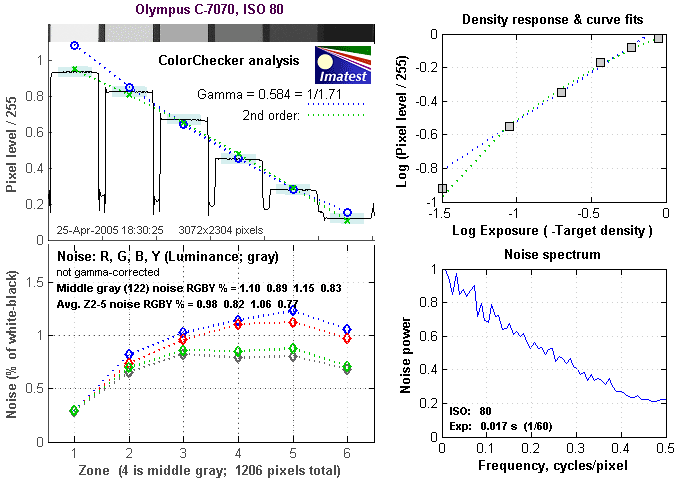
There's a lot in this particular graph, a lot more than I have room to go into here. Bottom line, the Olympus C-7070's noise levels are pretty low across the board, and the noise spectrum is such that the noise is fairly fine-grained, although not as much so as the best of its competitors. Still, the C-7070 benefits from the good noise performance that appears to be characteristic of the current generation of 7-megapixel CCD chips.
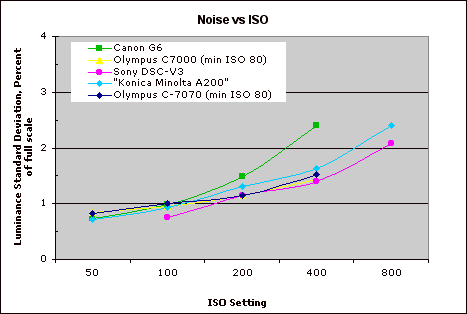
This chart compares the Olympus C-7070's noise performance over a range of ISOs against that of other cameras. As you can see, the C-7070 comes in at the low end of the scale, across the ISO range relative to most of its competition. What isn't shown here though, is the "grain" structure of the camera nor the extent to which it trades away fine detail as the ISO is increased. The C-7070 does fairly well in both these respects, although its noise is neither quite as fine-grained, nor its fine detail quite as sharp as some models. There's no free lunch with any camera though: One of the C-7070's main competitors, the Canon G6 does a better job of preserving subject detail, but as you can see from the graph above, its noise levels are as a result quite a bit higher. (Based on visual appearance, I'd give the noise-performance nod to the G6, but it's not by a wide margin, and some people might even prefer the "look" of the C-7070's high-ISO images.)
The chart above shows consolidated results from spatial frequency response measurements in both the horizontal and vertical axes. The "MTF 50" numbers tend to correlate best with visual perceptions of sharpness, so those are what I focus on here. The uncorrected resolution figures are 1378 line widths per picture height in the horizontal direction (corresponding to the vertically-oriented edge), and 1396 along the vertical axis (corresponding to the horizontally-oriented edge), for a combined average of 1387 LW/PH. Correcting to a "standardized" sharpening with a one-pixel radius increases this number a fair bit, to an average of 1934 LW/PH. The uncorrected numbers are on the low side for a 7-megapixel camera, the corrected ones are quite good. (This highlights the fact that you'll get the best resolution from the C-7070 by shooting with the camera's sharpening set to its lowest value, and then sharpening the images post-capture in Photoshop or some other imaging program.)
Per the note in the graph above though, the C-7070's images tended to clip somewhat, either at the low or the high end of the tonal scale, due to the default sharpening applied by the camera. I found that adjusting the exposure so the blacks didn't clip resulted in severe clipping of the whites. The amount of clipping represented here is fairly minor, so I think the resolution values are actually quite accurate. (I could eliminate the clipping by turning down the in-camera sharpening, but that would put the 7070 at a disadvantage with other cameras I test. Given that the clipping was so slight, I elected to just leave things as they were.)
For the real techno-geeks, the two plots below show the actual edge response of the C-7070, for horizontal and vertical edges. (Here, you can see the overshoot caused by the sharpening algorithm, and the extent to which it is reduced by Imatest's correction to a "standard" 1-pixel edge sharpening, as well as the very slight clipping in the blacks. The clipping appears as the very slight flattening on the bottom of the black curves, at their lowest points.)
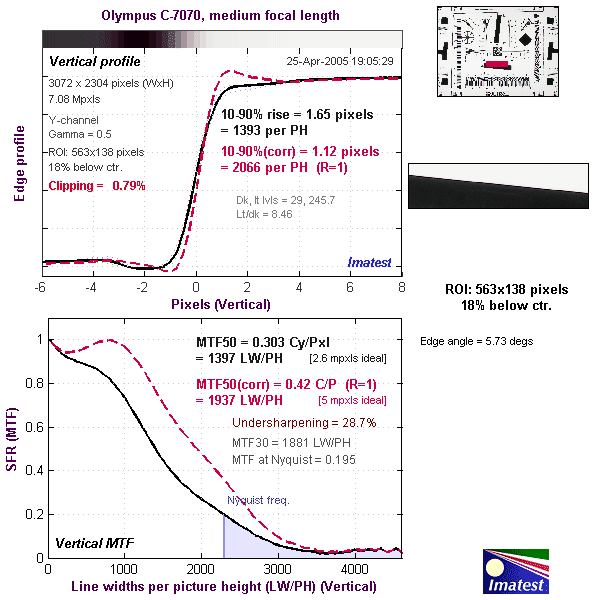
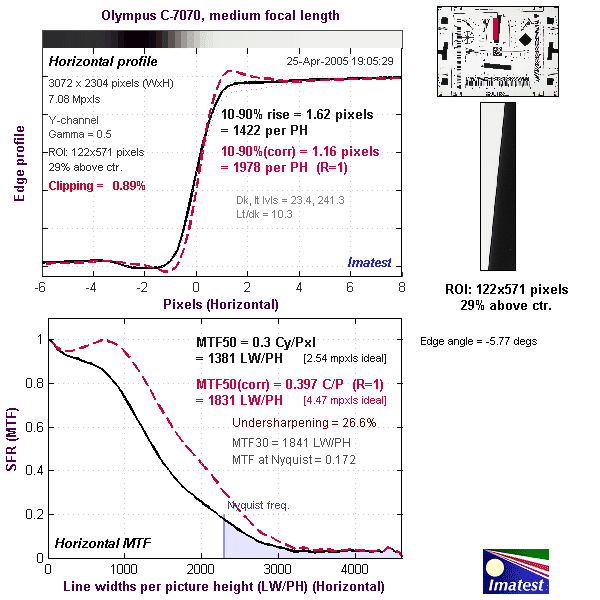
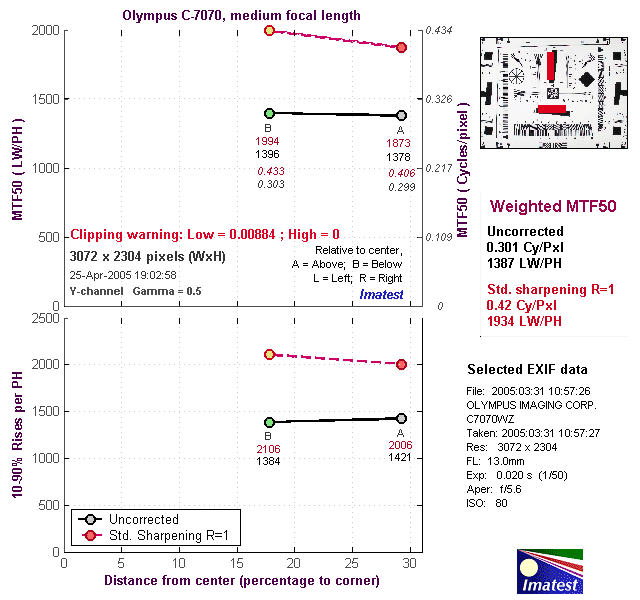

Follow Imaging Resource: